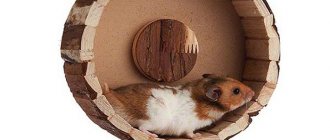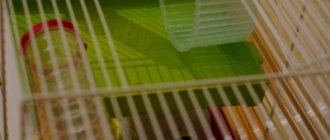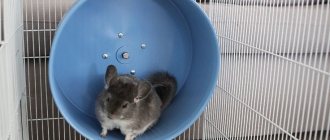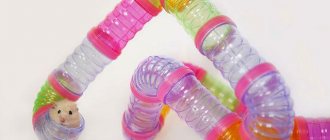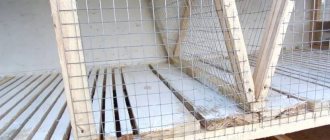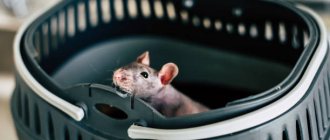Why does a hamster love running on a wheel?
Hamsters have an instinct for survival, that is, searching for food and protecting themselves from predatory animals and birds. You've probably noticed that as soon as you let him walk around the house, the first thing he does is examine the corners and places behind the furniture.
Therefore, nature rewarded rodents with increased activity. A wheel in a cage will help to expend the energy generated in the body as soon as it becomes necessary. The speed of movement of hamsters is approximately 5 km/h, which is the same as when a person walks on foot. The hamster's endurance is also surprising.
He can run 12 km in 10-12 hours.
Hay
Hay is a versatile product that can be used not only as filler, but also as food. It has a pleasant aroma and natural composition.
Beast Moe meadow hay 0.6 kg/20 l
The product is made from dried meadow hay. The composition also includes field grasses, which are used as bedding. If necessary, hay can be used as feed. In this case, the product will saturate the pet’s body with useful substances, vitamins and other beneficial components.
The main benefit of hay is that it strengthens the immune system. In addition, the product gives the coat a natural look and healthy shine. Suitable for guinea pigs, reptiles, birds, rabbits, degas and chinchillas. The hay is stored in a secure package, which is secured with a metal clip. The filler is well compressed, so the pack contains only meadow herbs.
Advantages:
- environmentally friendly composition;
- pleasant smell of meadow herbs;
- the hay is cleared of dust;
- does not cause allergies;
- reliable packaging;
- economical consumption;
- good value for money;
- no fragrance;
- the hay is well compacted.
Flaws:
- does not absorb moisture well;
- sometimes there is dust in the composition;
- quality varies between batches;
- small variety of herbs.
Customer Reviews
Vitakraft VITA VERDE meadow hay with dandelion flowers 0.5 kg
The product is high in fiber. The hay contains dandelion flowers, timothy and meadow grasses. In addition, hay is low in calcium. Thanks to this, the product is not only tasty, but also healthy for your pet. Hay promotes optimal digestion and prevents abrasion of the incisors.
The filler also contains minerals, vitamins, micro- and macroelements. Thanks to this, your pet's immunity will increase. For hay, grasses that are subject to gentle drying are used. This provides healthy and natural nutrition.
But the main purpose of hay is as a filler. The product absorbs moisture well and masks unpleasant odors. In addition, hay is used economically.
Advantages:
- the hay is well compacted;
- pleasant aroma of meadow flowers and herbs;
- no fragrance;
- does not cause allergies;
- environmentally friendly composition;
- tight packaging;
- good value for money;
- economical consumption.
Flaws:
- sometimes there is dust in the composition;
- small variety of herbs.
Customer Reviews
What materials are best to make it from?
You can make a wheel from many available materials:
- Tree. Wooden wheels are made from small boards. Ice cream sticks are perfect for this purpose. You will also need a rectangular wooden beam and metal wire. Such a wheel turns out to be durable and requires virtually no financial costs. But if it is not weighted down from below, then it can turn over while running, since it weighs very little.
- Tin can or disk. To make it you will need a tin can of the required size, a screwdriver, a knife for cutting metal, a glue gun, and wire. The design is also quite durable. But if the edges of the jar are not treated, the hamster may cut himself on them. In addition, this design does not look very aesthetically pleasing.
- Cardboard. This wheel is suitable for small rodents, as it is not durable. The design is very simple to make; even a child can do it under the supervision of an adult. Be sure to choose a thick cardboard so that it does not sag under the weight of the hamster.
Have you decided to make a wheel from natural materials?
Treadmills
Despite the fact that wheels have proven themselves well among chinchilla owners and are very popular, it is worth paying attention to treadmills. Experts believe that they are more convenient and safer for animals, since they do not load the spine and do not lead to damage. In addition, unlike wheels, this product does not make noise.
Despite the fact that today you can buy almost any simulators for these rodents in pet stores, sometimes it is more advisable to make such items yourself. This is not difficult to do. Making your own products can help you save money and create an original and more convenient exercise machine. Wheels for small pets are usually made from wood or a regular saucepan.
What you need to do it yourself
To make a homemade wheel you will need:
- wooden board as a base;
- stick as an axis;
- compass;
- sandpaper;
- ruler;
- hacksaw;
- stationery knife;
- pencil;
- scissors;
- perforator;
- materials for the wheel body (wooden sticks, cardboard, metal or plastic container, wire).
Important! Small children cannot use cutting objects on their own, so you need to call your parents for help.
Hard drive toy
Before you develop your own chinchilla wheel from the mentioned item, you need to prepare the following materials and tools:
- wide and light tin container;
- upholstery material (for example, cotton fabric or cork mat);
- electrical tape;
- hot glue;
- wire or nylon ties;
- screwdriver;
- scissors for cutting metal;
- marker.
If there is no damaged or old hard drive, this part can be replaced with the motor from the drive.
Step-by-step instructions: how to make a hamster wheel with your own hands at home
Before starting the manufacturing process, you need to study the structural features of a hamster wheel, decide on the size and other characteristics. This will help you make the perfect wheel that your rodent will definitely love.
Running wheel diameter
The most important thing is to choose the right wheel size so that your hamster can run comfortably in it:
- a diameter of 12 cm is suitable for a young hamster;
- for an adult rodent 16-18 cm;
- jungarika – 10 cm.
Important! As your pet grows up, he will need to change the wheel to a larger version.
Surface of the running wheel
The hamster should be comfortable running in the simulator. Therefore, the inner surface must be made ribbed. The rodent will be able to grab onto it with its paws and rotate the cylinder. Corrugated cardboard works well for these purposes. If you are making a wheel from plastic or metal, you will need to cover the inner surface with fabric.
Made of wood
You can make a wooden wheel according to the following instructions:
- Take a thin board and draw 2 circles with the selected diameter.
- Cut out one of them whole, and inside the second, draw a circle with a diameter less than 1 cm and cut it out too.
- On a solid circle, make a hole in the center and several more small holes around it.
- Take the popsicle sticks and cut them so that they are 5-6 cm long.
- Connect both parts using sticks and a hot gun, creating a wall for the rodent to run along.
- Using a nut and screw, screw the wheel to the wall of the cage.
From a hard drive and a jar
You can make a hamster wheel from a can in half an hour using improvised means:
- Select a container of the required diameter.
- Measure 5-6 cm from the bottom along the wall and cut off the excess.
- Sand the edges and interior surface with sandpaper.
- Take a cocktail tube and connect 2 points of the circle with it so that it runs through the center.
- Glue the edges with tape or a glue gun.
- Make holes in the center of the bottom of the jar and in the middle of the straw.
- Stick a wooden skewer into them.
- Check that the wheel rotates freely along the axle.
From cardboard
It’s as easy as shelling pears to make a wheel out of cardboard paper:
- Draw on cardboard and cut out blanks for the future wheel with a stationery knife: two circles of the same size with holes for the rodent, 2 parts in the shape of the letter “P” for attaching the wheel, a strip 5-6 cm wide and equal to the length of the circle.
- Bend the strip, connecting its edges, and glue it between the circles.
- Take a knitting needle and thread it through the centers of the circles.
- Attach the sides.
- Bend the ends of the knitting needles so that the circle does not fly off.
Nuances in making a running wheel
When working on the simulator, the following points must be taken into account:
- the wheel must rotate freely around its axis;
- it must be stable and not lose balance when a hamster gets into it;
- Don't forget to trim the edges so your pet doesn't get hurt.
Important! Remains of glue must be removed from the surface so that the rodent does not accidentally swallow it.
Ten good cages for hamsters
ZOLUX Rody Mini
Quite stylish and beautiful French-made products. It is made from high-quality hygienic plastic; the design also contains metal elements. Its overall dimensions are small, so dwarf hamsters will feel best in it - the size of the cage is 21x18x33 cm. The product comes complete with a bottle made of food-grade plastic, its volume is 75 ml, there is also a feeder, a wheel and two flat stoppers with holes. The design includes horizontal rods, which are quite suitable for placing additional devices.
More: TOP 10 best drugs to protect animals from external parasites
The design of the cage is attractive and well thought out - the product will optimally fit into almost any interior. The plastic is transparent, so it is convenient to observe the hamster. The tray is high - the filler will not fly through it into the room. The plastic parts have a streamlined shape, so the hamster will not be able to chew through them and escape.
Advantages:
- Original appearance;
- Compact overall dimensions;
- High quality materials;
- It is possible to install additional accessories;
- Quite a decent package.
Flaws:
- Suitable for dwarf breed hamsters only;
- Decent price.
Cage ZOLUX Rody Mini
KREDO M022
A very spacious three-story model with a very rich set of equipment. The domestically made device is equipped with a deep lift, which prevents the pet from throwing litter left and right. The cage is very easy to carry - it has a plastic handle for this purpose. The rods are made of stainless steel and are positioned vertically - the animal will not be able to climb on them.
However, there is plenty of space for activity here. The overall dimensions of the product are 45x33x45 cm. The design includes a pet-friendly spiral staircase, which first leads to the second floor, and then to the third. The latter is presented in the form of a small shelf where a house shaped like a hamster’s head is located. The set also includes a wheel, a feeder and an automatic drinker.
Advantages:
- Large selection of colors;
- Dimensions suitable for one or two animals;
- High pallet sides.
Flaws:
- Animals cannot climb the vertical bars of the lattice; accessories cannot be attached to them.
Cage KREDO M022
N1 DKg187
It is not too large in overall dimensions, so it will fit well into the interior of a compact children's room. The size of the structure along the body is 23x25.7x30 cm. There are two full tiers inside, thanks to which even a large breed hamster will feel comfortable in such a cage. This product comes complete with a feeder, an automatic drinker, a screw-type drain, a shelf with a house and a wheel.
There is enough space for the animal to run through its daily movement limit. The cage can be disassembled if necessary. The locking system is reliable - the animal will not be able to open it from the inside, and the cat from the outside will not be able to reach it either. Available in various color options, so you can easily choose the one that suits your specific interior style.
Advantages:
- The internal space is quite enough even for a comfortable life for a large hamster;
- Long service life;
- Acceptable cost of the house;
- Expanded cage configuration;
- Reliable locking mechanism;
- Collapsible design.
Flaws:
- Not so easy to find in pet stores.
Cell N1 DKg187
Savic Spelos XL Metro
Belgian products have a very original design style. The design of the product is unique: the cage is made in the form of a two-tier box made of food-grade plastic. On the second level there is a shaped shelf with holes for placing a feeder, drinking bowl and wheels - all these accessories are supplied in the kit. There is also a tunnel made of transparent plastic leading outside. The ventilation system is represented by a lattice door located on the roof of the cage. There is only 7 mm between the bars - this distance will not allow even a dwarf hamster to get out.
In general, a Syrian hamster will feel quite comfortable in this house, since its size is 59x37x26 cm. All parts can be removed and washed if necessary. The box itself looks very modern, the bottom is high - sawdust or other filler will not spill out.
MORE: Top 10 Best Portable Tent Heaters
Advantages:
- Stylish appearance;
- Well-designed fresh air access system;
- Even a large hamster can live in a cage;
- High pallet walls.
Flaws:
- The cost is very high for a hamster cage.
Savic Spelos XL Metro Cage
Darell Terry-1 ECO
One of the cheapest models in our rating of the best cages for hamsters. The overall dimensions are small - 37x26x18 cm, which makes the design optimally suitable for installation on a table. The cage itself is lattice, and the lattice is made of ordinary steel, painted with powder paint. All the necessary accessories for your pet can be easily attached to the horizontally located rods, and the hamster can easily climb on them.
To increase the internal space, there is a second floor, where the animal can climb up a ladder. It is recommended to cover the shelf with a piece of plywood or plexiglass so that the hamster’s paws do not get stuck there. The cage comes complete with a house, a wheel, and a hinged door equipped with a very tight spring. It is located on the roof of the cage, so the pet is unlikely to be able to open it. Users note the reliability and durability of the design.
Advantages:
- Cheap products;
- The bars of the cage are located horizontally - the hamster can climb on them;
- The door is quite tight, located on the roof of the cage - the animal is unlikely to be able to get out through it.
Flaws:
- The second tier is made of lattice, so your pet’s paws can get stuck between the bars;
- Not suitable for Syrian hamster.
Cell Darell Terry-1 ECO
Triol Studio
It features an optimal price-quality ratio, as well as an unusual form factor. The cage is made in the form of a suitcase with a handle. The product has compact overall dimensions, so it is optimally suited for placement on a table - 33x21x23 cm. The product comes with an automatic drinker, a feeder, a pipe that acts as a tunnel, a wheel and a house. The bars in the cage are located horizontally, you can easily place various additional accessories on them, the side walls are made of fairly durable plastic with a streamlined shape - the animal will not be able to chew through it.
At first glance, it may seem that there is not enough free space here, but the house and labyrinths fully compensate for the lack of space. The door is very wide - it is convenient to pour food through it or take out the pet if, for example, the cage needs to be cleaned or disinfected. The bottom can be detached.
Advantages:
- Optimal price-quality ratio;
- Compact overall dimensions;
- Wide door;
- Reliable locks.
Flaws:
- Manufactured in one single color scheme.
Cage Triol Studio
Ferplast Criceti
This is one of the most spacious single-story cages that can be found on the domestic market. The height of its walls is decent - as much as 23 cm, and the bottom area is 51.5x31 cm. A small second tier is still present, but even the Syrian hamster will be quite satisfied with the first one. The cage's equipment is quite standard - it comes with a feeder, a wheel, a small house and an original drinking bowl, which will give water to the pet only if it needs it.
The bars of the cage are located horizontally - it is convenient to attach additional elements for the pet to them, and the animal itself will happily climb them, which is important, because hamsters are very mobile animals. The tray here is very deep, the hinged door is located on the roof of the structure.
Advantages:
- Large interior space;
- Quite affordable price;
- The filler will not spill over the floor or table;
- The rods are arranged horizontally.
Flaws:
- Needs free space;
- The tray is made of thin plastic.
Cage Ferplast Criceti
Credo 513B
In third place in our ranking of the best cages for hamsters is a domestically produced two-tier cage. It has dimensions of 47x30x37 cm, so it will be comfortable for hamsters of all sizes to live in. The design inside is very spacious and has increased strength. The tray is quite deep, made of reliable plastic - it will not break even if dropped from a height, and the hamster will not be able to chew through it. Cleaning the cage from litter is also very simple. There is a handle at the top so it can be used as a carry bag. The door here is of a sliding type, the hamster will not be able to open it.
More: Top 10 best tape measures for dogs, choosing a tape measure leash for dogs
In addition to significant interior space, it is quite comfortably furnished inside. In addition to the standard wheels, automatic drinker and feeder, there is a shelf to which a ladder leads. A house for the animal is installed on it, and there is a tunnel. The hamster can run pretty fast there. The bars do not rattle at all, so the cage can even be placed in the bedroom.
Advantages:
- Increased product range;
- The rods do not rattle under the hamster's claws;
- Sliding door;
- There is a carrying handle on the roof;
- Easy to clean;
- Suitable for hamsters of any breed.
Flaws:
- It is better to immediately purchase a new automatic waterer, since the complete one does not work very reliably, and the hamster may suffer from thirst.
Cage Kredo 513B
Triol Monstropolis
It has a unique shape and color scheme, which is stylized in the spirit of the cartoon “Monsters University”. Hamsters are very active animals, so such a cage will be very suitable for them, and it has optimal dimensions - 36x26x45 cm. The flooring system here is multi-level, so the internal usable area is significantly increased. A minimum set of accessories for the animal is included in the kit, and there are also tunnels, shelves and a house with a transparent roof through which it is easy to observe the animal.
Products are made from high-quality plastic and reliable metal. If desired, it can be completely disassembled. The door is located on one side and is locked securely - animals cannot open it from the outside or from the inside, including domestic predators.
Advantages:
- Excellent workmanship and assembly quality;
- Perfect for a first pet - the cage can be given to a child along with a hamster;
- Easy to clean;
- Absolutely collapsible;
- Not too expensive.
Flaws:
- A bit pricey.
Triol Monstropolis cage
Inter-Zoo G-020 TEDDY II
Our leader was one of the tallest models that can only be found in domestic pet stores. The bottom dimensions are quite standard - 37x25 cm, but the height is 51 cm. Using this constructive approach, you can place a huge number of different useful accessories for your pet inside. Due to an active lifestyle, the hamster will remain healthy for a long time. He can freely climb the bars of the cage. There are convenient stairs and spiral tunnels between the floors.
The cage is very reliable and absolutely safe for your pet. The spaces between the rods are narrow, but the shelves are also lattice, so they need to be covered with plywood, cardboard or plexiglass. The tray is very deep and easy to remove and clean. It is convenient to clean the floors of the cage due to separate doors.
Advantages:
- Spacious cage;
- High quality workmanship;
- A small distance between the bars will not allow the pet to get out of the cage.
Flaws:
- Not detected.
Cage Inter-Zoo G-020 TEDDY II
Types of simulator and mounts
Running wheels differ in their inner surface. It can be solid, lattice or mesh. It is safest to choose wheels without holes so that the hamster's paw cannot fall into it.
Wheels also differ in the type of fastening:
- to the cell wall. Saves space in the hamster's home, but when used it knocks on the rods or board.
- To the bottom of the cage. Such exercise machines are unstable and can tip over if the rodent starts to run.
- On a stand. The best option for hamsters if space in the cage is not limited. Very stable and causes minimal noise.
Cardboard
This type of simulator is very inexpensive, but not durable . In addition, the hamster can chew on it significantly during a break between runs. Anyone can make such a wheel, even without special skills.
This is a great option for hamsters who are just starting to run or as a temporary trainer until you get a more durable one.
Silent
Many people choose this type of exercise machine because hamsters love to run at night. The noise from the rotation of the wheel can be heard all night and interfere with sleep.
Thanks to the special design, the parts do not touch each other and do not create extraneous sounds. But it is worth noting that such wheels are much more expensive than regular ones.
Wood
A wooden treadmill keeps the environment around the rodent environmentally friendly. This is a big plus for his health. These wheels are a little more expensive than regular ones, but you can make them yourself.
Features of the structure of the running wheel
Any running wheel consists of a cylinder, which is mounted on an axle. When choosing a simulator, it is important to ensure that it rotates evenly and does not deviate to the sides. The wheel stand must be stable. Otherwise it will turn over.
Important! The design of the wheel should not contain foreign objects, for example, to decorate the simulator. They will interfere with the hamster's running and may cause injury.
Upgraded wheels
After using the wheel for a short time, many owners complain about extraneous squeaks or noises that the running wheels begin to create. If a metal wheel squeaks, you can lubricate it with vegetable oil, and the extraneous sounds will recede. In addition, the running wheel can be improved to make it as silent and useful as possible.
Some owners come up with a hamster wheel with a generator, so that the rodent spends its running time with benefit not only for itself, but also for its owner’s environment. Often these things are made by hand, since they do not require a lot of effort and technical steps, allowing you to get electricity for small purposes like charging a mobile phone, which an active rodent can handle.
Another way to reduce noise from a running wheel is to replace the plastic mount with a bearing. Then the wheel will work silently, and will also delight the owners with an additional bonus, since such an invention can be used as a generator.
Disadvantages of purchased hamster wheels
The main disadvantage of purchased wheels is their cost. A medium-sized exercise machine will cost no less than 700-1000 rubles. Plastic wheels may contain harmful impurities that will worsen the hamster's health.
Often, purchased hamster wheels are coated with paint that a rodent can tear off with its teeth. If it gets into the animal's stomach, it can cause intoxication. Therefore, things made with your own hands are sometimes safer for your beloved pets.
Plastic wheels
Such products have many positive aspects:
- animals do not chew them;
- the simulator is small in size;
- they are very easy to wash and disinfect;
- These wheels are cheap. Exercise machines for baby chinchillas can cost even less than 500 rubles, but prices for products for adults are also affordable.
Commercially available plastic wheels can be of two types - finely knurled and parallel crossbars. When choosing the latter, it is worth considering that they may be unsafe for animals. A chinchilla can seriously injure its paw if it steps between the bars.
How to train a rodent to run
Some hamsters don't understand why they need a wheel until they try to run in it. Others become lazy over time and don't want to move much. Experts recommend using the following tricks:
- Lure with a treat. You won't give your hamster a choice if you put food directly into the drum. You need to do this for several days in a row until the rodent itself begins to come and climb into the wheel.
- Blocking the exit. Take a piece of cardboard or a piece of wood and cover the entrance to the wheel with it when the hamster gets into it. He will only have to move in one direction, causing the wheel to rotate.
Why do you need a running wheel for chinchillas?
Pet breeders often wonder how necessary a wheel is. This attribute is required to prevent the chinchilla's muscle atrophy from occurring. Regular use of the wheel by a pet whose mobility is limited within the cage is important. Plus, running on a wheel is a fun activity for your pet.
Possible problems
Even using such a simple design can cause difficulties. Most often, hamsters refuse to run in a wheel. It also happens that over time the wheel begins to squeak.
The wheel squeaks
The structure may creak as a result of prolonged use. The parts deform over time and come into contact with each other during rotation. The solution is to lubricate the surfaces with oil. If a new wheel squeaks a lot, it may be defective.
Hamster doesn't run on a wheel
This problem can occur for several reasons:
- The rodent doesn't like the wheel. Try replacing it with a machine made of a different material or with a different design.
- The hamster has a hard time turning the wheel. This may happen due to the age of the animal. Rodents older than 2-3 years are considered old and they lose the desire to move a lot.
- The hamster has an injury. It may also happen that the rodent injured its paw or hit itself. Find out by watching him. If he used to be cheerful and active, but suddenly suddenly stopped running and playing, you should take him to the vet.
Making a wheel from an aluminum pan
Making a treadmill from a saucepan is much easier than making it from a sheet of plywood. To do this, you only need an unnecessary or slightly damaged kitchen product of a suitable size. Since the height of the pan is quite large for the animal, which can lead to injury, you need to saw off the edges of the product by approximately 13–16 centimeters.
The edges of the pan must be thoroughly sanded to make them smooth and remove sharp burrs. After this, the wheel must be attached to the tensioner pulley.
Prevention and care of the house
To protect your pet, the installation of the house is carried out with an eye to prevention:
- the dwelling must be tightly attached to the wall or mesh;
- Careful adjustment of the surfaces is important (no gaps where a curious animal would immediately stick its paw);
- various chips and cracks are excluded;
- It is extremely undesirable to use traumatic fasteners - iron screws or self-tapping screws.
Home maintenance is quite simple.
Video: how to clean a chinchilla’s display case It is enough to promptly remove the remains of food that has got there and the old layer of sawdust from the house. To do this, the structure is simply raised.
It is advisable to wipe the walls with the same frequency (once a week) with a slightly damp cloth.
Major disinfection is carried out every 2-3 months. All surfaces of the house are wiped with swabs soaked in an alcohol solution of salicylic acid (concentration 1 or 2%). But there is one caveat - before use it is mixed with boiled water in equal parts.
Cage installation
These animals are social animals, and when they have at least one more degu in their houses, they are simply happy. Your pets love to communicate, so don't leave them unattended. By the way, they can often start chatting excitedly or even grumbling nervously, and this cannot but touch you. The average lifespan of these animals is 5-10 years. Before you get these cute furry animals, consider the following.
The degu will constantly need nutritious food, fresh fresh water and a clean habitat. Degus need daily exercise and play
All members of your family should understand how to keep a pet. Degus are social animals, so you need to constantly communicate with them and pay attention to them. Of all rodent species, degus require more free space.
How to choose or make your own toys for chinchillas?
If a pet chinchilla has nothing to do, it begins to tear its fur. This is a sad sight not only for pet owners; this condition is dangerous for the animal itself.
Let's figure out how to play with a chinchilla at home and tell you what toys will amuse your little pet.
Main types of toys
Toys for chinchillas presented in online stores are divided into 2 large groups:
- static, allowing you not only to entertain your pet, but also to decorate the interior;
- moving, designed for active games not only inside the cage, but also outside it.
Let's take a closer look at them.
Tunnel
Chinchillas love to hide in wooden and plastic pipes. Choose a transparent product to easily find a pet that has fallen asleep after wasting energy
Pay attention to the size. If the diameter of the tunnel is less than 30 cm, then the animal may get stuck
When choosing wood, pay attention to the edges. The rodent will quickly wear them down if they are not made of metal
Hammock
Manufacturers offer rag, plastic and wooden versions of hammocks with 1 or 2 tiers. In the case of several levels, the pet will receive an additional place to hide.
Shelf
Powerful hind legs need activity, so placing 1 or more shelves will provide excellent exercise. When installing, keep the height not exceeding 80 cm. Otherwise, the animal may be injured if it jumps unsuccessfully.
Ladder
Miniature ladders develop paws and are suitable for back scratching and sharpening teeth. An ordinary wooden stick placed vertically can be a budget option. Chinchillas love to jump and the ladder is an excellent exercise machine for them.
Walking ball
A plastic product allows you to walk around the room, but poor ventilation significantly reduces the walking time. Frequent cases of overheating of animals is a serious disadvantage of this interesting little thing.
For the safety of the chinchilla, you need to keep track of time, so instead of buying such a dubious toy, remove unnecessary objects from the room and let the animal run around on its own.
DIY toys for chinchillas
Some manufacturers, trying to reduce costs, skimp on quality. As a result, the final product not only loses quality, but also becomes dangerous.
Products to avoid:
- from cheap plastic, lime, glass, rubber, cement, cardboard and paper;
- containing small parts (during play the rodent may choke on them);
- bright colors (all factory paint will transfer to the animal’s fur);
- with sharp corners and rough surface;
- with a strong odor, indicating an excessive amount of dangerous chemicals;
- from pine needles, oak and cherry containing resin (poisoning).
The best solution to the problem is to make toys for the chinchilla with your own hands. A handmade item will not only protect your pet from an unscrupulous manufacturer, but will also help you save money.
Hammock design
The design of a hammock for a chinchilla is simple. In the classic version, this is a piece of durable but pleasant-to-touch material, the corners of which are securely attached to the cage bars using carabiners or other fasteners.
Fabric structures differ favorably from other types in that they take a shape that matches the contours of the animal’s body, thereby providing maximum convenience and comfort. But if the animal gnaws its bed, you should choose other - more durable - materials.
As for the types of construction, there are two main types:
- single-tier (simple flat bed);
- two-tier or pipe-shaped (a volumetric hammock - the animal can be placed both on top and inside; climbing to the lower tier, the animal finds itself in a “house” - reliable and warm).
